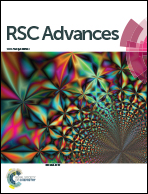Epoxy composite with high thermal conductivity by constructing 3D-oriented carbon fiber and BN network structure
Abstract
As electronic devices tend to be integrated and high-powered, thermal conductivity is regarded as the crucial parameter of electronic components, which has become the main factor that limits the operating speed and service lifetime of electronic devices. However, constructing continuous thermal conductive paths for low content particle fillers and reducing interface thermal resistance between fillers and matrix are still two challenging issues for the preparation of thermally conductive composites. In this study, 3D-oriented carbon fiber (CF) thermal network structures filled with boron nitride flakes (BN) as thermal conductive bridges were successfully constructed. The epoxy composite was fabricated by thermal conductive material with a 3D oriented structure by the vacuum liquid impregnation method. This special 3D-oriented structure modified by BN (BN/CF) could efficiently broaden the heat conduction pathway and connected adjacent fibers, which leads to the reduction of thermal resistance. The thermal conductivity of the boron nitride/carbon fiber/epoxy resin composite (BN/CF/EP) with 5 vol% 10 mm CF and 40 vol% BN reaches up to 3.1 W m−1 K−1, and its conductivity is only 2.5 × 10−4 S cm−1. This facile and high-efficient method could provide some useful advice for the thermal management material in the microelectronic field and aerospace industry.



 Please wait while we load your content...
Please wait while we load your content...